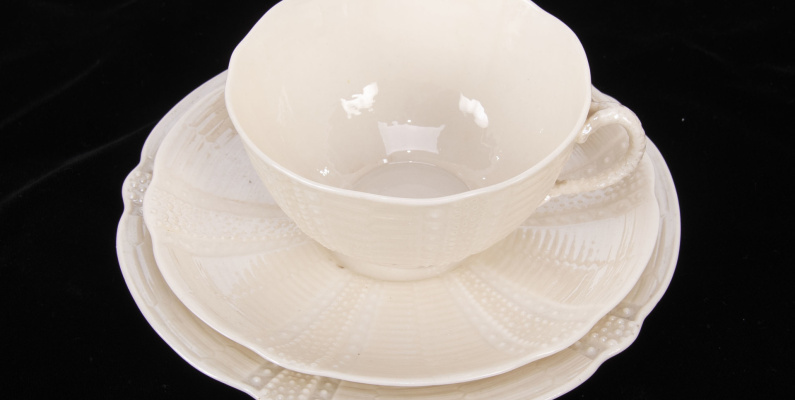
To celebrate International Tea Day on Sunday 15 December, our lovely Curator, Humanities, Moira White is here to tell us about one of porcelain's most beloved brands, Belleek, which makes a simple cup of tea a thing of delicate beauty.
Ireland’s Belleek Pottery, established in 1857, is celebrated internationally for the distinctive iridescent glaze; the “brilliant mother-of-pearl-like hues” [1] on many of its products.
Located in County Fermanagh, in the north-west of the island, Belleek was nearly as well known in the first decades of its existence for its economic success, providing employment for up to 200 people, and using local products.
Tea ware was Belleek’s largest output. Marion Langham described their basic déjeuner (breakfast service) as made up of “a tray, teapot, cream, sugar and two or four cups and saucers”. [2] Some designs had a greater number of pieces, or were expanded following their initial release.
Belleek’s ‘Echinus’ tea service (in the image at the top), designed by Mrs Annie Langley Nairn and registered in 1869, was based on the sea urchin. It is still their best known, perhaps because Queen Victoria ordered a set for herself and another for her daughter. A number of other Belleek tea sets reference sea creatures and other marine themes, including: ‘Neptune’, (pictured below) named after the Roman god of the sea, with cups in the form of a number of sea shells, coral-like handles, and small gastropod ‘feet’; ‘Shell’ designed using a mixture of shells and coral; ‘Tridacna’, with shapes and patterning inspired by the clam shell; and ‘Limpet’.

Image: Neptune pattern cup, saucer and plate by Belleek, 1890s – 1920s, owned by Erna Blackman. F2010.9 Gift of Gary and Margery Blackman. By Jen Copedo © Otago Museum Collection
“The latest ceramic craze is 'Belleek' ware”, read the New Zealand Tablet in 1889. “Belleek is an Irish porcelain which is thinner than the proverbial egg-shell, and boasts of an iridescent glaze, to be seen on nothing else than the inner shell of a pearl oyster. How the nacre is caught and fixed upon the exquisite pottery passes the comprehension of all save those who make it.” [3]
Later that year, the Tablet heaped more praise on this “beautiful branch of Irish manufacture”, noting the publication of an article by Miss Mary Georges on the pottery, adding, “Belleek ware, as everybody knows, is the most delicate and exquisite produced anywhere ...”
It was available at a number of Dunedin retailers. The DIC, Ritchie’s, Gordon’s, and Brown, Ewing & Co all advertised having it in stock in different decades. In 1900, the latter told Otago Daily Times readers that Belleek was “in the opinion of many competent judges, the finest in the world. Mr Brown, whilst visiting Ireland recently, stayed at Belleek, and selected for us a Parcel of the Prettiest and Most Saleable Goods they make.”[4] As a result, they offered a Shell cup and saucer for 4/9d, a cream jug and sugar bowl for 2/6, or a Handsome Ornament for 8/6.
Charles de Kay wrote in 1914 that “Belleek ware is an attempt to repeat the firm golden glow of certain shells”. [5] The distinctive finish was so desirable that the word ‘Belleek’ was sometimes used to describe the general appearance of its imitators, as well as the products of the Irish company.

Image: Neptune pattern cup, saucer and plate by Belleek, 1890s – 1920s, owned by Erna Blackman. F2010.9 Gift of Gary and Margery Blackman. By Jen Copedo © Otago Museum Collection
In 1935, the Press reviewed a display of Belleek at the Canterbury Museum which demonstrated “the special peculiarities of ... lightness, translucence, a delicacy of texture, a fine cream tone of colour, and an iridescence or lustre not shown by the products of any other factory. The decorations are mostly shells, corals, dolphins, and mermaids, and are usually beautifully modelled. Other marine organisms were first used by the factory and with great skill and artistic effect.” Added to that, “The mark was characteristically Irish in design—a round tower, harp, greyhound, sprig of shamrock, over the word "Belleek." [6]
Visitors to the town of Belleek today can still visit the Belleek Pottery Museum.
Top Image: Echinus pattern cup, saucer and plate by Belleek, owned by Erna Blackman. F2010.10. Gift of Gary and Margery Blackman. By Jen Copedo © Otago Museum Collection
[1] John Haslem, 1876. The Old Derby China Factory: The Workmen and Their Productions London: G. Bell., p.13
[2] Marion Langham, 1993. Belleek Irish Porcelain. London: Quiller Press.
[3] New Zealand Tablet, 12 July 1889, p.11
[4] Otago Daily Times, 31 December 1900, p.6
[5] Charles de Kay, 1917. ‘A Realm of Beauty for Artists to Explore’, The Art World p.263
[6] Press, Volume 22 July 1935, p.12
